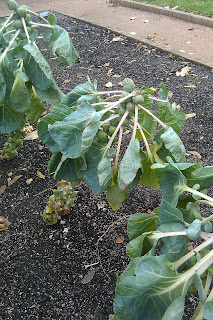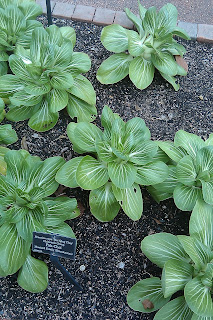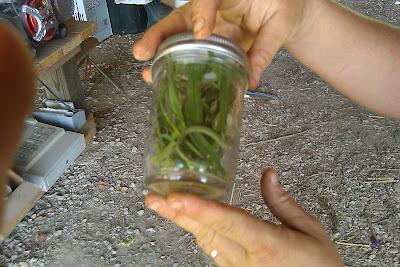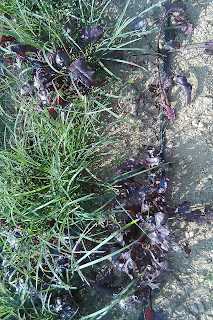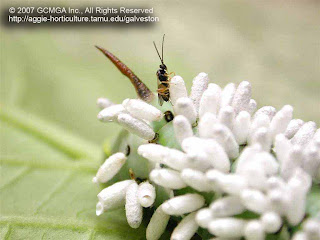First, a little trivia: turkeys have different names depending on their gender and their age. Try to match the name to the type of turkey. Answers are at the bottom of this post.
| 1. Gobbler | a. Female adult |
| 2. Jake | b. Male adult |
| 3. Tom | c. Hatchling |
| 4. Poult | d. Young male |
| 5. Hen | e. Male adult (Yes, there are 2 of these.) |
Before this spring, the most I knew about turkeys was how to cook one and that Ben Franklin thought they'd be a better choice for our national bird than the bald eagle. Then one day, on a early spring hike, I got sucked in to the turkey world. My husband and I both heard a peculiar cackling sound up ahead of us, and as we hiked nearer, the sounds became quite loud. We easily located the sounds' sources: two tom turkeys up in two trees gobbling back and forth at each other, apparently arguing over who would be a better mate for the next female turkey that should happen along. The turkeys displayed their stereotypical puffed-up colorful chest and tail feathers, looking like Liberace versus Porter Wagoner.
My husband quickly figured out that the toms were as willing to gobble at him as they were to gobble at each other. He had a rather long conversation with the toms, which got more interesting when the husband of another hiking couple joined in too. What is it with guys and turkey noises?
 |
| Non-agitated foraging turkey toms. (Photo by C. Sams) |
It turns out that adult male turkeys spend a rather large percentage of their time agitated - either arguing with other males or trying to impress females. When agitated, they puff up all their feathers and their featherless head skin rapidly changes colors from red to white to blue. They also have erectile tissue on their faces (of all places!) that stands at attention when they are attempting to attract a mate. All turkeys have extra flaps of tissue on their faces, but males have the snood (the fore-mentioned face penis), the wattle (hanging under the beak) and the dewlap (webbing connecting the chin to the neck), in addition to caruncles (warty growths on all adult turkeys). Female turkeys are drab, less warty and less bald - though much more handsome than they sound from this description.
Domesticated turkeys are the same species as the wild turkey, but they have been selected for white feathers, extreme muscle mass, and quick growth. Domesticated turkeys are so overgrown that it is physically impossible for a male turkey to copulate with a female turkey, and all domesticated turkeys must be artificially inseminated (there's a career for you!). It is also nearly impossible for domesticated turkeys to fly after adolescence, as they are weighted down by their big, juicy light and dark meat.
Turkeys are social animals, and they will forage for food and hunt for mates in groups when given the chance. Farmed turkeys grow better and faster when allowed to be near other turkeys. But when grown with thousands of other turkeys in close conditions, as is the case with the standard large turkey barns, their social behaviors can lead to odd and grisly problems. Any turkey with the slightest wound to its head will be quickly pecked to death by the other turkeys around it. A single male turkey in a barn of all females will suffer a similar fate. A female in a male barn will be trampled by the males attempting to mate. Strange. Turkeys are gender segregated and often have their beaks trimmed to reduce economic loss from turkey attacks.
Like the chicken, turkeys have light meat on their breasts and wings, since these muscles are less used by these non-flying birds. The standing muscles in their legs are used constantly, so they are the dark meat.
 |
| Light and dark meat a few seconds before being eaten. |
There tends to be more fat stored in the turkeys' legs, which makes dark meat richer and moister in a cooked bird. Turkeys are notorious for drying out as they cook because they take a LONG time to cook (much longer than you think). Since they have so much more muscle mass than chickens, by the time heat from a cooking oven has reached the center of the bird, the outside of the bird has had all its moisture evaporated, becoming stringy and dry. This problem is made worse by cooking a turkey with stuffing inside the body cavity. When the bird is stuffed, it basically becomes a big ball of food that can only be cooked from the outside in. The stuffing often is not cooked thoroughly and can carry salmonella (as my poor cousin discovered the first time she hosted the entire family for Thanksgiving). Without stuffing, air from the oven can bring heat inside the bird, and the meat cooks from the outside in as well as the inside out. When the cook bastes the turkey (pours the turkey cooking juices over the cooking turkey) a few times during the cooking process, the white meat can retain more moisture. The cook can also cook the turkey at a lower temperature for longer to keep the surface of the bird from drying out. Of course, there's always gravy.
 |
| Basting the turkey to keep the light meat moist. |
Congratulations on sticking with the turkey post. You will be rewarded with answers to the quiz from the beginning of this post. Hens are adult females. Gobblers and toms are adult males. Jakes are young males. Poults are hatchlings (which are unusually able to run around and feed very quickly after hatching).
I promise it won't be as long until the next post. We'll get back to plants next time.






